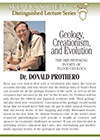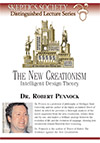
The Price of Altruism
From “survival of the fittest” to “the selfish gene,” familiar evolutionary themes advocate an amoral viewpoint that favors the individual. And yet, evolutionary biologists have uncovered countless examples of altruism in animals and humans — and learned that there is an evolutionary component to these selfless behaviors which can be quantified.
This week on Skepticality, Swoopy talks with Professor Oren Harman, author of The Price of Altruism: George Price and the Search for the Origins of Kindness. Both a history of the study of social evolution and a biography of George R. Price, this book explores a life which would become an illuminating experiment in altruism and lead to the development of the Price equation (a mathematical equation used to study genetic evolution).
In this week’s eSkeptic, we present David Eller’s article from the archives of Skeptic magazine Volume 10, Number 3 in which he argues that Intelligent Design Creationism’s concept of microcreation fails to strengthen the case for macrocreation nor weaken the case for macroevolution.
David Eller was born a skeptic and freethinker and never saw any reason to change. He is a cultural anthropologist in Denver, Colorado, and has published numerous articles on anthropology and on rationalist/freethought topics. He and has written textbooks on violence and culture, religion and culture and culture and culture. He is the author of From Culture to Ethnicity to Conflict, Natural Atheism, and Atheism Advanced: Further Thoughts of a Freethinker.

Macroevolution & Microcreationism
Another Flaw in Intelligent Design Creationism
by David Eller
A STANDARD TACTIC USED by creationists to attack evolution is to contrast microevolution (i.e., within species evolution, which they accept) with macroevolution (i.e., between species evolution, which they adamantly reject). Microevolution, they grant, may or does occur. But they assert that macroevolution either has never been observed or is theoretically impossible. They argue that while microevolution may be true, it is trivial, and the major claim of evolution — the evolution and emergence of species — is either unsubstantiated or false.
This failure to account for macrophenomena, such as human life, the earth, or the universe, then serves as an opportunity to suggest that creation is the only plausible alternative for the origin of life. This conclusion suffers from the fallacy of the excluded middle or false dilemma (just because B is false does not make A true). But ironically the “success” of the “scientific” creationist enterprise, particularly its most recent and “serious” incarnation — Intelligent Design (ID) — has itself up to this point rested on claims regarding a few minor fragmentary subspecies processes rather than the macroprocesses that it is so keen to deny to evolution.
I argue in this article that creationism faces its own micro/macro distinction and challenge, and that ID has so far only focused on and made claims about microprocesses. Finally, I posit that whatever achievements microcreation may have made or may have imagined it made, these achievements neither strengthen the case for macrocreation nor weaken the case for macroevolution.
Microevolution and Macrocreation
The modern synthesis of evolutionary theory aims to be a “complete” theory. It postulates processes that function at the subspecies as well as the species levels and uniformly throughout the living world. The details may vary , but biochemical systems, species, and living systems as a whole evolve by way of natural processes. Finally, most if not all of these processes — mutation, natural selection, genetic drift, symbiosis, etc. — have been identified and described.
Even within evolutionary theory the distinction between “micro” changes and “macro” changes is widely accepted. In the simplest sense, microevolution is modification within a species. It is the (relatively) minor variation or development that leads to, say, different colors of a species of moth or different strains of a species of bacteria. Darwin himself said as much when he described “descent with modification” as the gradual accumulation of novelty and diversity. Prior to passing a “critical mass” of accumulated modification, evolution will be intraspecies. However, at a certain point, a threshold would be crossed, and the accumulated novelty would result in a transition between species, the emergence of a new species out of an old one — that is, speciation. Even more, at a still higher level, a threshold would have to be crossed to move from an entire order or class or ultimately kingdom of species: at some point, primates must diverge from mammals, mammals from reptiles, and even animals from plants. Granted, this accomplishment would take many, many generations, so we would not expect to observe it happening before our eyes, unlike microevolution, which is often observable over a few generations of a species and within the lifetime of a human observer. Still, if macroevolution actually occurs, it ought to leave some traces, particularly “transitional forms,” that link primates to other mammals, mammals to reptiles, and animals to plants.
Creationism is more difficult to pin down, since there are so many differing and even conflicting versions of it. Some claim that one or more supernatural beings brought all of the variety of the universe into existence at one time with a word or thought. Others claim that creation has been a more “ongoing” phenomenon, with a creator working through physical or natural processes to achieve the conditions existing today. Some think it was all a recent accomplishment, some an ancient one. Some assert specific knowledge of the creation, others offer only the suggestion that there is/was a creation. No matter what the details, creationism also purports to be a complete explanation. In fact, whether or not it purports to be, it is obligated to be, since no theory can leave key facts and processes unaccounted for.
Of the available creationisms, the one that most seeks and claims scientific respectability is ID. It consists of an assortment of scholarly activities, some “logical” or polemical (essentially, trying to discredit evolutionary theory) and some “empirical” or evidential. Among the evidential work of the movement, perhaps Michael Behe’s Darwin’s Black Box1 best represents what “creation science” looks like. In this book, Behe describes, in fairly technical terminology, certain biological systems, including the flagella of protists, the human eye, and the blood-clotting system, and argues that they reveal an extremely ordered and “purposive” nature. Each system is assembled from myriad parts that individually would have no useful function but which, together in specific ways, have an invaluable function. Thus, these systems evince an “irreducible complexity” that did not (and could not) evolve unintentionally. The parts of the system had to have been purposefully, that is intelligently, designed with their end — their combination and function — in mind.
Behe’s work, and, as far as I know, the subsequent work of ID, does not make any explicit empirical claims about large-scale design. For instance, Behe certainly does not claim in Darwin’s Black Box that humans were intelligently designed or that the Earth or the Universe was so designed. There are, of course, other researchers at work, some associated with the ID movement, who attempt to extend the design notion. Those who advance the “anthropic principle,”2 especially in its “strong version,” insist that the universe itself shows such complex, unlikely, and purposive qualities that it must have been designed by some non-immanent intelligence as well. This would definitely constitute a “macrocreationist” view. A scientific creationist account of the appearance of the human species or of any (and all) other species would also necessarily be macrocreationism.
However, Behe and most of the effort of the ID movement is not directed at this level or about these questions. They focus on subspecies, microlevel phenomena, like flagella and eyes. Such explanations constitute a kind of microcreationism — claims about how lower-level, intraspecies systems or parts of systems came into being. Microcreation, then, is entirely comparable to microevolution. But neither is a sufficient theory by itself. Evolution demands macroevolution and creationism demands macrocreationism.
Before we proceed to ask whether microcreation supports macrocreation (and refutes macroevolution), let us ask another question: since creationism of whatever sort intends to displace and supercede evolution, why would it give credence to microevolution, which might provide grounds for macroevolution? Why tolerate any level of evolution? One possible answer is that ID creationists see microevolution as no threat to their program. As long as the “basic” or “fundamental” or “irreducible” qualities are set in motion — something that IDers stipulate could not have happened through “blind” and “dumb” processes — then tinkering of the microevolutionary sort is permissible. In other words, an intelligent designer is necessary to design the eye, but once designed, the eye could microevolve into diverse versions.
A more likely answer, however, is that ID creationists do not deny microevolution because they cannot deny it. It is perfectly obvious and incontrovertible that it happens. We see variations in traits, even wholly new traits, emerge in existing species routinely and ordinarily. Bacteria and viruses (micro-) evolve new drug-resistant strains. Insects (micro-) evolve into new types. We humans have even artificially (micro-) evolved dogs and cats, for instance, into a plethora of different breeds, and with genetic technologies we stand on the verge — or have crossed the verge — of (micro-) evolving all kinds of plants and animals. It would require a suicidal degree of stupidity to deny that microevolution happens rather often and easily. Scientific creationists insist, however, that such events have nothing to do with and lend no credence to macroevolution.
Is Microcreation An Effective Argument?
It is plain to see that ID theory and research is a kind of microcreationist project, on a par with microevolution. Both are interesting programs, but neither addresses the bigger and ultimately unavoidable questions. Still, no doubt microcreation is meant to pave the way for macrocreation, in the same manner that microevolution is an incremental step in macroevolution. The two questions for us are, then: (1) Does microcreation make the case for macrocreation stronger, and (2) Does microcreation make the case for macroevolution weaker? Unfortunately for the ID enthusiasts, both answers are no. It is, in the end, an ineffective argument, even if it were to prove true.
Why does microcreation not strengthen the case for macrocreation? First and foremost, macrocreation is at best an analogy or extrapolation of microcreation and at worst an erroneous misapplication of it — an instance of the fallacy of composition. This well-known fallacy states that you should not ascribe a characteristic to a whole object simply because it is ascribed to part of the object. The same might be contended about microevolution, but it really cannot be, as we will see below.

One of the many serious charges against microcreation is that it does not offer any specific mechanisms for the creation process. If a flagellum or an eye or a clotting system is designed, how is it designed? A claim is not scientific or theoretical merely by taking factual topics as its subject; a scientific or theoretical answer must suggest some mechanisms or means by which those facts came about. Just saying, “It is designed” says nothing. What are the steps in the design process? How is that design implemented into real physical matter? If such questions cannot be answered at the microcreation level, then it is useless as a premise for the macrocreation level.
Related to the question of design method is the question of designer: who or what is this designer? ID theorists cannot evade the fact that a specific intelligent entity is being posited as the solution to what they consider otherwise insurmountable problems; “mindless” natural processes cannot account for the results, so there must be a mindful processor. But again, this is a nonanswer without more content. Admittedly, Behe speculates about a creator, supposing that it might be an alien life form or an interdimensional being, or even the conventional idea of a god. However, speculation is not knowledge, and the answer — whatever answer — ID settles upon, it faces another even more vexing question: where did that designer come from? If all irreducibly complex phenomena have a creator, and the creator is him/itself irreducibly complex, then he/it must have a creator, ad infinitum. Having not solved this problem (in fact, having probably started an insoluble problem), they cannot extrapolate a solution from micro to macro.
Finally, while microcreation might solve one microproblem — that is, the explanation of “function” or “purpose” at the micro level — it says nothing and can say nothing about the issue of macrofunction or macropurpose. Okay, let us grant that the purpose of all the irreducibly complex parts of a flagellum is the motility of a protist, and some intelligence has created and assembled the parts for that function. What is the purpose of the protist? A single-celled life form is indisputably complex, but what is it for? Design without purpose is irrational; designed has to mean not only “designed by” but “designed for.” Let us grant that the human eye is designed for the purpose of vision in a human being. What is the purpose of vision? What is the purpose of the human being? Similarly, what is the purpose of a mosquito, a planet, or a universe? At the macro level, purpose seems to escape, even if it is detectable at the micro level. I suppose it might be possible to conclude that an intelligence designed the flagellum and then left it for protists to exploit, or that he/it designed the eye and then left it for humans to exploit, but I am sure that this is not where macrocreationists want to end up, and it also seems ultimately absurd. You cannot leave flagella and eyes lying about and expect anything interesting to happen to them.
So it seems that even if we grant the microcreationists their claims (and we do not), this does not aid macrocreationist claims one bit. Let us then consider our other question: does microcreation decrease the likelihood or sensibleness of macroevolution? Again, the answer is no. First, microcreation does not refute microevolution and may in fact depend on it; perhaps a designer designed the first flagellum or eye, but unless he, she or it was very industrious, each particular instantiation of a flagellum or eye was not independently created. That is, even if we grant that “the eye” (the basic blueprint or plan for an eye) was designed, that does not mean — and I don’t think that microcreationists want to insist — that the human eye was designed independently of the cat eye independently of the fish eye independently of the bird eye, etc. So they could allow and probably must allow that, having set the “model” or “blueprint” in motion, the designer could or did step back and let microevolutionary processes run.
Also, as we said, creationists cannot deny microevolution, unless they want to maintain that every time a new strain of virus evolves it is really the designer stepping back in to redesign his creation. While possible to imagine, it is hard to believe and impossible to prove, and it still raises the objection: why would a beneficent designer keep improving his pests?
The really damaging aspect of the creationist tolerance of microevolution, though, is this: microevolution has a mechanism. Even the most hardheaded creationist who accepts the reality of microevolution must admit that it operates by natural processes such as natural selection, genetic drift, mutation, symbiosis, preferential selection, and the like. However, having allowed these processes into the world, there is no way to restrict their scope. If these processes can effect minor, or at least intraspecies modification over remarkably short time spans, there is no reason in principle why these same processes could not effect major modification, i.e., speciation, over remarkably long time spans.
Further, since microevolution does not depend on a problematic concept like (micro) purpose, there is no demand that macroevolution satisfy any (macro-) purpose qualifications. Evolution, from Darwin on, relies strictly on “blind” or non-teleological forces, and ones which work equally well at the micro and macro levels. That is why we stated at the outset that evolution is a complete theory: it encompasses both micro and macro variation and emergence under exactly the same mechanisms. It does not need (although it might with effort be made consonant with) any ancillary or external forces or factors. In other words, microevolution is the same thing as macroevolution in every important sense, and microcreation does not and cannot change that fact. In reality, it is a much larger leap from microcreation to macrocreation than it is from microevolution to macroevolution.
One last objection that some anti-evolutionists might raise is that the “transitional forms” that we predict do not exist. They contend this weakens, if not falsifies, the case for evolution. The response to this charge is three-fold. First, a great number of transitional forms have been discovered, and it is disingenuous of critics to keep demanding “missing links” when links are provided; it is always possible to say, “OK, you found a link between 1 and 2, namely 11/2, but what is the missing link between 1 and 11/2 ?” This reductio ad absurdum must be resisted, and creationists must be compelled to explain when they would be satisfied with the intermediate evidence. My fear is that they never will be.
Second, critics of evolution must concede that evolutionary research has not been going on all that long, and that the limitations of fossilization and excavation make discovery of any forms, transitional or not, a tricky affair. Some evolutionists have even suggested that the periods of transition may have been relatively short and abrupt (the notion of “punctuated equilibrium”), a sudden mass speciation something akin to the sudden mass extinctions at the end of the Permian and the Cretaceous periods. If this is the case, then transitional forms would be the least likely to be unearthed today. Some respond that this is an opportunistic solution to a serious problem, and it may be, or it may be an accurate solution to the problem.
Third and finally, the demand for transitional forms is a double-edged sword for creationists. Adversaries of creationism might with justification ask for evidence of transitional designs. This evidence might consist of either designs that are in between other designs (i.e., the transitional eye between a human and cat or a human and reptile) or that are “under development” or unfinished (i.e., the blueprint for an eye or an eye “in progress”). Since I have never heard of any such evidence, nor have I heard a microcreationist speak of such evidence, I conclude that it does not exist. Of course, they might respond that the designer is not only intelligent but perfect, so he, she or it does not make in-between or unfinished designs, but this is an additional postulated quality of the designer that itself must be proved, and the claim is at least as opportunistic as any punctuated equilibrium theory that evolutionists have ever advanced.

Conclusion: The Failure of Microcreation
Microcreation fails in every regard. It is not a complete explanation of natural phenomena. It fails on a number of levels: it does not account for macrolevel entities, nor does to lead inevitably to macrocreation as a “second stage” in creation, nor does it posit a mechanism by which either could occur. Additionally, it does not refute evolution as a sound and complete explanation of the same phenomena. In fact, it generally grants microevolution, which does inevitably lead to macroevolution as a second stage in evolution and does provide a mechanism by which both occur.
For, in the end, microevolution is nothing more than descent with modification over the short term, and macroevolution is descent with modification over the long term. Put another way, macroevolution is merely the accumulation of microevolutionary changes. The only difference between them is time-scale. The same thing cannot be said about microcreation and macrocreation. Macrocreation is not the accumulation of microcreationist events; if it were, then macrocreation would be “blind” or incidental. You do not get a flagellum over the short term and a protist over the long term. Where would the flagellum reside in the meantime? We can conclude with confidence that microcreation fails as an explanation even of microlevel phenomena and that, even if it were it to succeed at that level, it would still fail as a ground for macrocreation.
References
- Behe, Michael. 1996. Darwin’s Black Box. NY: The Free Press.
- For instance, Barrow, John and Tipler, Frank 1988. The Anthropic Cosmological Principle. NY: Oxford University Press and Tipler, Frank 1995. The Physics of Immortality: Modern Cosmology, God, and the Resurrection of the Dead. NY: Doubleday.
Skeptical perspectives on creationism and evolution
-
 Geology, Creationism and Evolution:
Geology, Creationism and Evolution:
The Breathtaking Inanity of Flood Geology
(DVD $23.95 CD $15.95) by Dr. Donald Prothero -
In this lecture at Caltech, Dr. Donald Prothero — one of the world’s most respected paleontologists — provides a wealth of evidence and answers to creationist challenges to science. If you are interstested in defending science education don’t miss this entertaining and intellectually rigorous history of the geological and fossil record… Read more…
-
 The New Creationism: Intelligent Design Theory
The New Creationism: Intelligent Design Theory
(paperback $15.95) by Dr. Robert Pennock -
Dr. Pennock has written the most authoritative book on the new creationism. In this lecture, he delivers a superbly organized and thorough analysis and refutation of the arguments from the new creationists. He covers ID theory, irreducible complexity and makes a brilliant analogy between the evolution of life and the evolution of language to show the deep flaws in creationists’ reasoning. READ more…
-
 How to Debate a Creationist
How to Debate a Creationist
(27 page booklet) -
One of our best-selling resources, this 27-page booklet includes 25 evolutionist answers to 25 creationist arguments, and 10 answers to Intelligent Design creationist arguments… Read more…

NEW ON SKEPTICBLOG.ORG
‘I didn’t know the mic was on’: Public Talk versus Private Talk
In this week’s Skepticblog post, Michael Shermer distinguishes between public talk and private talk and encourages those in a position of power and influence to assume that the microphone is on in either case.












